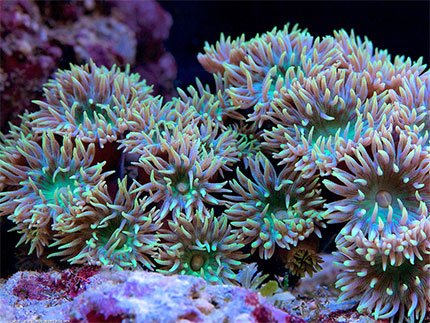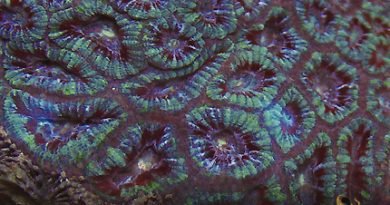Duncanopsammia
Commonly known as whisker coral or daisy coral, Duncanopsammia is considered rare in the United States, but a common addition to Australian coral reefs. Usually found in deeper water near sandy substrate, it is very adaptable to varying lighting conditions.
The color of Duncan can vary from gray-pink to light green on the tentacles, a pink to intense blue-green on the oral disc, and brown to bright green on the corallites. The size of the polyps (including the tentacles) can be up to approximately 4.5 cm across. Duncanopsammia is a fast grower if given the right conditions.
Duncanopsammia are a popular addition to home or office saltwater tanks. They require low to medium lighting, and low to medium water flow. Feeding tentacles appear during the evening ad while exposed, will feed on meaty foods such as brine shrimp or micro-plankton. For continued health, it will also require the addition of strontium, calcium, and other trace elements to the water in the tank.
Softer corals can be more delicate than their stony-type, harder counterparts. When placing Duncanopsammia in a tank, it’s important to make sure its secure, and will not be knocked over. It is not an outwardly aggressive coral, but should be placed with plenty of space between itself and other corals, because it can expand twice its size during the day. Make sure it is secure, so it will not be knocked over, which may damage the skin and cause an infection.
Propagation of the Duncanopsammia is as easy as cutting the ‘stem’ of the coral to separate the polyps. As this coral grows upwards it will not attach itself properly to reef structures. If your coral is in a tank, it is best to attach it using aquarium putty to ensure its safety.
This type of coral is very beautiful to look at. While it does exist in reef structures throughout the world, its delicate nature often prevents it from being plentiful in an ocean atmosphere, unless the conditions are exactly right. It can be more expensive to purchase than other types of coral, but the beauty that the Duncanopsammia brings to saltwater fish tanks is well worth the price. Its delicate beauty and array of colors make it an aquarium enthusiast favorite.
Exploring the Fascinating World of Duncanopsammia Corals
Duncanopsammia, commonly known as Duncan Coral or Whisker Coral, is a genus of large-polyped stony corals that captivate marine enthusiasts and aquarists alike. This article delves into the intricate world of Duncanopsammia, exploring its biology, care requirements in aquaria, environmental impact, and propagation techniques.
Understanding Duncanopsammia’s Biology
The Unique Structure of Duncan Coral
Duncanopsammia axifuga, the scientific name for Duncan Coral, exhibits a fascinating skeletal structure, integral to its survival and growth. Each polyp of Duncanopsammia is supported by a calcium carbonate skeleton, which not only provides physical support but also plays a crucial role in the coral’s growth patterns. The polyps extend their tentacles at night to capture plankton and other small organisms, showcasing their predatory nature in the marine ecosystem. This nocturnal feeding habit is essential for their sustenance, especially in nutrient-poor waters.
Photosynthesis and Symbiotic Relationships
Duncanopsammia corals host symbiotic algae known as zooxanthellae within their tissues. This symbiotic relationship is paramount for their survival. The zooxanthellae perform photosynthesis, providing essential nutrients to the coral, while in return, they receive protection and access to sunlight. This process not only contributes to the coral’s vibrant colors but also plays a significant role in the energy dynamics of coral reef ecosystems.
Care and Maintenance in Aquariums
Optimal Water Conditions for Duncan Coral
To thrive in an aquarium setting, Duncanopsammia requires specific water conditions. Ideal parameters include a stable temperature range of 72-78°F (22-25°C), a pH level between 8.1 and 8.4, and salinity levels close to natural seawater (1.023-1.025 specific gravity). Additionally, moderate water flow and lighting are crucial for their well-being, mimicking their natural habitat conditions. Regular monitoring of these parameters is essential for the health and growth of Duncan corals in captivity.
Feeding and Nutritional Needs
Feeding Duncanopsammia in an aquarium environment is vital for its growth and coloration. They benefit from a varied diet consisting of microplankton, brine shrimp, and specially formulated coral foods. Feeding should be done cautiously, as overfeeding can lead to water quality issues. It’s also important to note that while Duncanopsammia can derive some nutrients from photosynthesis, supplemental feeding ensures optimal health and vibrant coloration.
Environmental Impact and Significance
Role in Marine Ecosystems
Duncanopsammia plays a significant role in marine ecosystems, particularly in coral reef environments. They provide habitat and shelter for various marine organisms, contributing to biodiversity. The structure of Duncan Coral reefs also helps in buffering shorelines against erosion, showcasing their environmental significance beyond aesthetics.
Indicators of Ocean Health
Duncan corals, like many other coral species, serve as indicators of ocean health. Their sensitivity to water quality and temperature makes them effective bioindicators. Changes in their health and appearance can signal alterations in the marine environment, often due to factors like climate change, pollution, and ocean acidification. Monitoring their status can provide valuable insights into the health of marine ecosystems.
Propagation and Sustainability
Fragmentation and Aquaculture
Propagation of Duncanopsammia through fragmentation is a common practice among aquarists. This method involves carefully breaking off a piece of the coral, which then grows into a new colony. This technique not only helps in sustainable coral keeping but also aids in conservation efforts by reducing the need for wild coral harvesting.
Conservation Efforts in Aquaculture
Efforts in aquaculture have significantly contributed to the conservation of Duncanopsammia species. By cultivating them in controlled environments, the pressure on wild populations is reduced. Aquaculture also provides an opportunity for research and understanding of coral biology, aiding in the development of effective conservation strategies.
In conclusion, Duncanopsammia corals are not only mesmerizing additions to marine aquaria but also vital components of marine ecosystems. Their unique biology, care requirements, and role in the environment highlight the importance of their conservation. By understanding and respecting these magnificent creatures, we can ensure their survival for future generations to enjoy.
FAQs About Duncanopsammia
- What is the ideal temperature range for Duncanopsammia in an aquarium? The ideal temperature range for Duncanopsammia in an aquarium is between 72-78°F (22-25°C). Maintaining this temperature range is crucial for the coral’s health, as it mimics their natural habitat conditions.
- How does Duncanopsammia contribute to its ecosystem? Duncanopsammia contributes significantly to its ecosystem by providing shelter and habitat for various marine organisms, thus enhancing biodiversity. Additionally, their structure helps protect shorelines.




